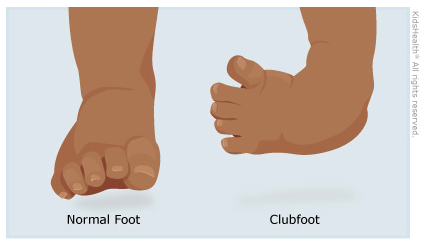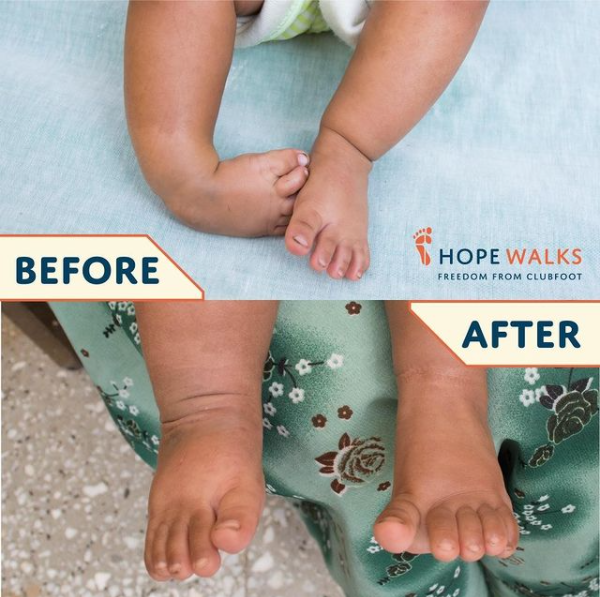World Clubfoot Day Celebrates the Birth of Ignacio Ponseti, a Pioneer in Clubfoot Treatment
Many Infants with Clubfoot in Developing Countries Still Go Untreated
By Adrian Cook, Director of Research and Evaluation
Having clubfoot should not even be a memory…
When boys or girls bend down to tie their shoes during a soccer match or put on sandals to do chores, they should be looking down at feet that are straight and strong. Children should have no thought of their feet ever being anything other than the feet that allow them to experience the fullness of life.
 Every year nearly 200,000 children are born with feet that are twisted down and inward caused by a congenital deformity.[i] This condition is commonly called clubfoot.
Every year nearly 200,000 children are born with feet that are twisted down and inward caused by a congenital deformity.[i] This condition is commonly called clubfoot.
80 percent of children with clubfoot are born in middle and low-income countries.[ii] For these children the prospects of treatment are challenging because of significant barriers to care, despite the fact that there is an effective, low-cost treatment modality called the Ponseti method that will correct feet at the earliest ages and allow for normal functioning for the rest of life.
Kaleb* is a rambunctious 3-year-old. At his family’s home in Adama, Ethiopia, Kaleb spills popcorn as he shares it with guests. He mischievously steals balloons from his older brother. And he runs around as three-year-old boys should. Kaleb has no thought that he was born with clubfoot.
Amara*, Kaleb’s mother, took him to the clubfoot clinic at the local hospital for treatment within a few months of Kaleb’s birth. At the local hospital, Kaleb was treated by experienced physiotherapists who have been trained in the Ponseti method of serial casting.
The Ponseti method is recognized as the standard of care for young children. Kaleb visited the clubfoot clinic weekly over five weeks for gentle manipulation of his feet and casting to hold his feet in the right position. After the weeks of casting, Kaleb had his Achilles tendon released and received a final casting. The final stage of treatment is to wear a foot brace, which prevents relapse. Kaleb will wear a brace while he sleeps until he is four or five years of age.
Hope Walks
Like thousands of other children who were born with clubfoot, Kaleb can now run and experience life with full-functioning feet. However, for every Ethiopian child who received clubfoot treatment like Kaleb, there are two others who do not receive treatment. This statistic is similar in low- and middle-income countries around the world because of barriers like distance to treatment, ability to pay, and even knowledge that clubfoot can be successfully treated.
The clinic that Kaleb visited in Adama, Ethiopia is coordinated by Hope Walks, an organization working to overcome barriers and treat children with clubfoot before they turn two years old. Motivated by hope in Christ, “Hope Walks frees children, families, and communities from the burden of clubfoot.”[iii] The model implemented by Hope Walks involves training physiotherapists in the Ponseti treatment method, collaborating with healthcare clinics to provide treatment, raising awareness among parents and caregivers about clubfoot treatment, and walking alongside families as they go through the journey of caring for their child.
Hope Walks models Jesus’ example of showing love by serving well, and sharing the gospel through what they say and what they do.[iv] Kaleb experienced Hope Walks’ approach through the treatment of his clubfoot condition that will last a lifetime. Kaleb’s family experienced encouragement and knowledge that empowered them thanks to the parent advisors at Hope Walks. Being separated from her family that reside in another region of Ethiopia, Kaleb’s mother was especially encouraged by the spiritual support provided by Hope Walks. Motivated by his experience with Hope Walks, and the hope it instilled, Kaleb’s father shared treatment opportunities with other fathers of children with clubfoot.
Because Kaleb received treatment for his feet within a few months of birth, as he grows older, Kaleb will not remember that his feet were ever disabled. On World Clubfoot Day, The Rees-Jones Foundation celebrates the healing Kaleb experienced while also recognizing that there is work to be done to connect thousands of other children with treatment. The Foundation looks forward to celebrating the day when all children with clubfoot receive the care they deserve.
Clubfoot in Ethiopia
In Ethiopia it is estimated 4,500 children are born annually with clubfoot. Currently 39 percent are treated before the age of two. The Rees-Jones Foundation works through partners to provide families with access to clubfoot treatment. Treating clubfoot while a child is an infant prevents a lifetime of disability and hardship.
The Foundation has supported Hope Walks and CURE International in their efforts to provide treatment to children with clubfoot.
Hope Walks
Hope Walks is a Christian international non-profit organization working in 16 countries to treat children born with clubfoot. Hope Walks focuses on treating infants and children under the age of two with the Ponseti method of clubfoot treatment.
Hope Walks engages the healthcare sectors of the countries they work in by training physicians, nurses, physiotherapists, and other midlevel providers in the Ponseti method and collaborating with healthcare facilities to operate regular clubfoot clinics. Clinic services include parent supports that serve the spiritual and human needs of families as they care for their children. Additionally, Hope Walks raises awareness about clubfoot treatment among parents and health and human services providers.
Hope Walks is a leading partner of the Global Clubfoot Initiative which has a strategy, Run Free 2030, to end clubfoot disability by 2030.
CURE International
CURE International is a Christian international non-profit organization working in eight countries through its network of hospitals to surgically treat children with orthopedic and neuro conditions. A significant constituency of CURE International is youth with neglected clubfoot conditions. These youth have complex disability conditions caused by living with clubfoot for many years without treatment or with incomplete treatment.
CURE International is a leader in innovating in the treatment of neglected clubfoot conditions.
*Patient names changed for confidentiality.
[i] Global Clubfoot Initiative, https://globalclubfoot.com/clubfoot/
[ii] Global Clubfoot Initiative, https://globalclubfoot.com/clubfoot/
[iii] Hope Walks, https://www.hopewalks.org/our-mission/
[iv] Hope Walks, https://www.hopewalks.org/our-work/
Share this post:
Category: Original Content
Remember to Whom We Belong By T. Hardie, President For to us a child is born, to…



